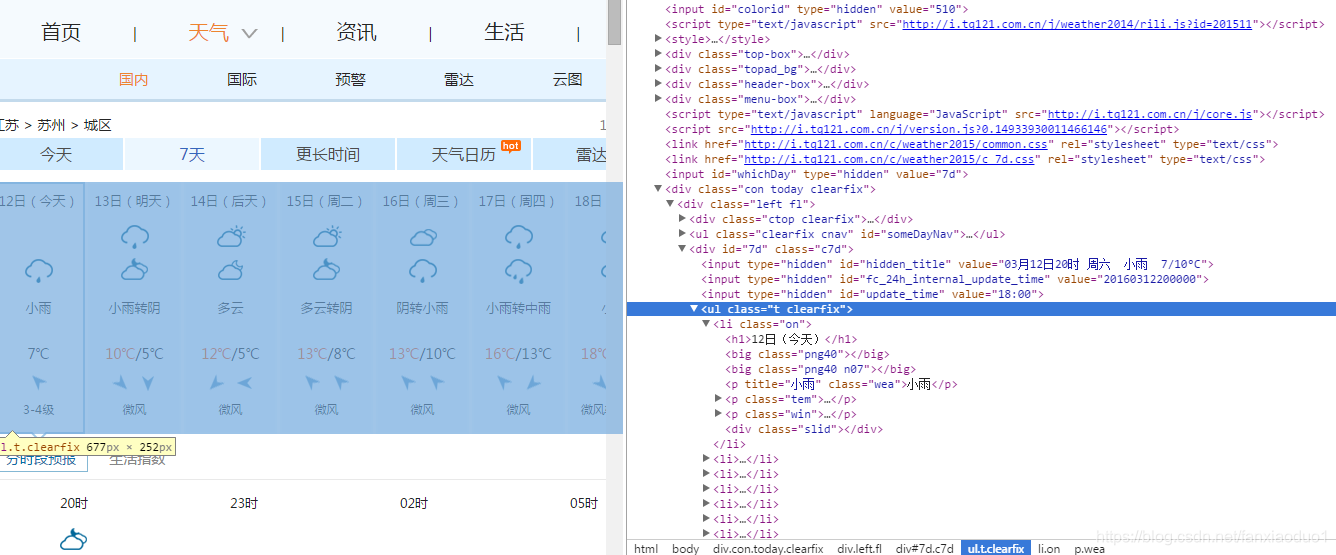实战2、pycharm+python+MS SQLSERVER实现爬虫程序。
实现 python 爬老毛桃网站 https://www.laomaotao.net/ u盘启动制作工具 所有版本号,然后写入MS SQLSERVER数据库中
稍后更新...

首先在pycharm的点左下角的 Terminal ,输入pip install requests 和 pip install BeautifulSoup4 安装包
一、先热下身,写第一个 爬百度网站。
import requests
from bs4 import BeautifulSoup
resp=requests.get('https://www.baidu.com') #请求百度首页
print(resp) #打印请求结果的状态码
print(resp.content) #打印请求到的网页源码
bsobj=BeautifulSoup(resp.content,'lxml') #将网页源码构造成BeautifulSoup对象,方便操作
a_list=bsobj.find_all('a') #获取网页中的所有a标签对象
text='' # 创建一个空字符串
for a in a_list:
href=a.get('href') #获取a标签对象的href属性,即这个对象指向的链接地址
text+=href+'\n' #加入到字符串中,并换行
with open('url.txt','w') as f: #在当前路径下,以写的方式打开一个名为'url.txt',如果不存在则创建
f.write(text) #将text里的数据写入到文本中
二、爬 老毛桃网站

老毛桃网站有防爬,所以我改为另一个网友的例子并加入写入数据库部分。
我们要爬的网站 http://www.weather.com.cn/weather/101190401.shtml

1、首先在MS SQLSERVER 中 建立新表t_tq


2、pycharm IDE 中选new project->pure python , 在项目上新建一个python文件testtq.py 然后拷贝入如下代码
import requests
import csv
import random
import time
import socket
import http.client
# import urllib.request
from bs4 import BeautifulSoup
import pymssql
def insert(results):
# Create your views here.
# 打开数据库连接
db = pymssql.connect(host='127.0.0.1', user='sa', password='3201319', database='bhjs', port=1433)
# 使用cursor()方法获取操作游标
cur = db.cursor()
sql = "INSERT INTO t_tq (rq,tq,zgwd,zdwd) VALUES (%s, %s, %s, %s)"
try:
cur.execute(sql,(results['rq'],results['tq'],results['zgwd'],results['zdwd'])) # 执行sql语句
#results = cur.fetchall() # 所有记录
db.commit()
except Exception as e:
raise e
return results
def get_content(url , data = None):
header={
'Accept': 'text/html,application/xhtml+xml,application/xml;q=0.9,image/webp,*/*;q=0.8',
'Accept-Encoding': 'gzip, deflate, sdch',
'Accept-Language': 'zh-CN,zh;q=0.8',
'Connection': 'keep-alive',
'User-Agent': 'Mozilla/5.0 (Windows NT 6.3; WOW64) AppleWebKit/537.36 (KHTML, like Gecko) Chrome/43.0.235'
}
timeout = random.choice(range(80, 180))
while True:
try:
rep = requests.get(url,headers = header,timeout = timeout)
rep.encoding = 'utf-8'
# req = urllib.request.Request(url, data, header)
# response = urllib.request.urlopen(req, timeout=timeout)
# html1 = response.read().decode('UTF-8', errors='ignore')
# response.close()
break
# except urllib.request.HTTPError as e:
# print( '1:', e)
# time.sleep(random.choice(range(5, 10)))
#
# except urllib.request.URLError as e:
# print( '2:', e)
# time.sleep(random.choice(range(5, 10)))
except socket.timeout as e:
print( '3:', e)
time.sleep(random.choice(range(8,15)))
except socket.error as e:
print( '4:', e)
time.sleep(random.choice(range(20, 60)))
except http.client.BadStatusLine as e:
print( '5:', e)
time.sleep(random.choice(range(30, 80)))
except http.client.IncompleteRead as e:
print( '6:', e)
time.sleep(random.choice(range(5, 15)))
return rep.text
def get_data(html_text):
item_p={'rq':50,'tq':50,'zgwd':50,'zdwd':50}
final = []
bs = BeautifulSoup(html_text, "html.parser") # 创建BeautifulSoup对象
body = bs.body # 获取body部分
data = body.find('div', {'id': '7d'}) # 找到id为7d的div
ul = data.find('ul') # 获取ul部分
li = ul.find_all('li') # 获取所有的li
for day in li: # 对每个li标签中的内容进行遍历
temp = []
date = day.find('h1').string # 找到日期
temp.append(date) # 添加到temp中
item_p['rq']=date
inf = day.find_all('p') # 找到li中的所有p标签
temp.append(inf[0].string) # 第一个p标签中的内容(天气状况)加到temp中
item_p['tq']=inf[0].string
if inf[1].find('span') is None:
temperature_highest = None # 天气预报可能没有当天的最高气温(到了傍晚,就是这样),需要加个判断语句,来输出最低气温
else:
temperature_highest = inf[1].find('span').string # 找到最高温
temperature_highest = temperature_highest.replace('℃', '') # 到了晚上网站会变,最高温度后面也有个℃
temperature_lowest = inf[1].find('i').string # 找到最低温
temperature_lowest = temperature_lowest.replace('℃', '') # 最低温度后面有个℃,去掉这个符号
temp.append(temperature_highest) # 将最高温添加到temp中
temp.append(temperature_lowest) #将最低温添加到temp中
item_p['zgwd']=temperature_highest
item_p['zdwd']=temperature_lowest
final.append(temp) #将temp加到final中
insert(item_p)
return final
def write_data(data, name):
file_name = name
with open(file_name, 'a', errors='ignore', newline='') as f:
f_csv = csv.writer(f)
f_csv.writerows(data)
if __name__ == '__main__':
url ='http://www.weather.com.cn/weather/101190401.shtml'
html = get_content(url)
result = get_data(html)
# write_data(result, 'weather.csv')
3、运行,在SQLSERVER中可得到如下结果

打呆仗,结硬寨,用最好的工具。——曾国藩
https://www.jetbrains.com/zh-cn/

